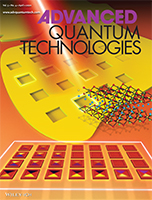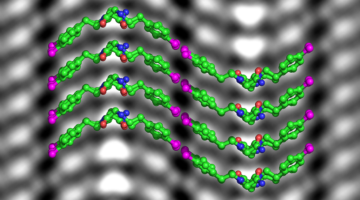Multimodal probes revealed a way to prevent the formation of undesirable phases in a perovskite-type compound that shows promise for the efficient harvesting of light for solar cells. The work led to new fabrication protocols that resulted in devices with improved power-conversion efficiencies and operational stability. Read more »![]()
![]()
In Situ and Operando Characterizations of Metal Halide Perovskite and Solar Cells: Insights from Lab-Sized Devices to Upscaling Processes
The performance and stability of metal halide perovskite solar cells strongly depend on precursor materials and deposition methods adopted during the perovskite layer preparation. This review presents an update of studies conducted in situ using a wide range of structural, imaging, and spectroscopic techniques, involving the formation/degradation of halide perovskites. Read more »
Scientists Grow Lead-Free Solar Material With a Built-In Switch
A new ferroelectric material—grown in the lab from cesium germanium tribromide (CGB)—opens the door to an easier approach to making solar cell devices. Unlike conventional solar materials, CGB crystals are inherently polarized, where one side of the crystal builds up positive charges and the other side builds up negative charges, no doping required. Read more »
Unexpected Transformations Reinforce Roman Architectural Concrete
Researchers used the ALS to study binding phases in Roman architectural concrete, revealing reactions and profound transformations that contribute to long-term cohesion and durability. The findings add to our growing understanding of cementing processes in Roman concretes, informing resilient materials of the future. Read more »![]()
![]()
Strategies for Reducing Platinum Waste in Fuel Cells
Industry and university researchers used the ALS to explore why the platinum used as a catalyst in hydrogen fuel cells degrades unevenly. The resulting knowledge has enabled the development of simple, effective strategies to reduce the waste of precious catalyst material, lowering the costs associated with a promising green technology. Read more »![]()
![]()
A Split-Screen View of Solar-Cell Crystallization
Researchers simultaneously monitored both the structure and function of a photovoltaic material as it crystallized from solution. The work raises the prospect of rationally tuning materials for optimal performance in photovoltaics and other light-manipulating devices, including light-emitting diodes, detectors, and lasers. Read more »![]()
![]()
New Technique Paves the Way for Perfect Perovskites
A new solar material, organic-inorganic halide perovskites, could one day help the U.S. achieve its solar ambitions and decarbonize the power grid. A recent study reports that manufacturing could be aided by a new instrument that uses invisible x-ray light and visible laser light to probe a perovskite material’s crystal structure and optical properties as it is synthesized. Read more »
Highly Enhanced Curie Temperature in Ga‐Implanted Fe3GeTe2 van der Waals Material
Researchers report an effective and reliable method of increasing the Curie temperature of ferromagnetic Fe3GeTe2 (FGT) van der Waals (vdW) material by Ga implantation, opening a new opportunity for tailoring the magnetic properties of vdW materials beyond room temperature for future spintronics applications. Read more »
Probing the Evolution of Photovoltaic Films during the Spin-Coating Process
A new, in-beamline spin-coating platform enabled researchers to probe the structure of a promising photovoltaic material in the crucial early stages of processing. The results demonstrate the power of multimodal in situ techniques as promising tools for optimizing synthesis parameters and, thus, device performance. Read more »
Freeze Frame: Scientists Capture Atomic-Scale Snapshots of Artificial Proteins
Protein-like molecules called polypeptoids have great promise as precision building blocks for creating a variety of designer nanomaterials. In this study, rsearchers used cryo-EM, a technique originally designed to image proteins in solution, as well as x-ray scattering techniques, to characterize the structure of polypeptide nanosheets. Read more »









